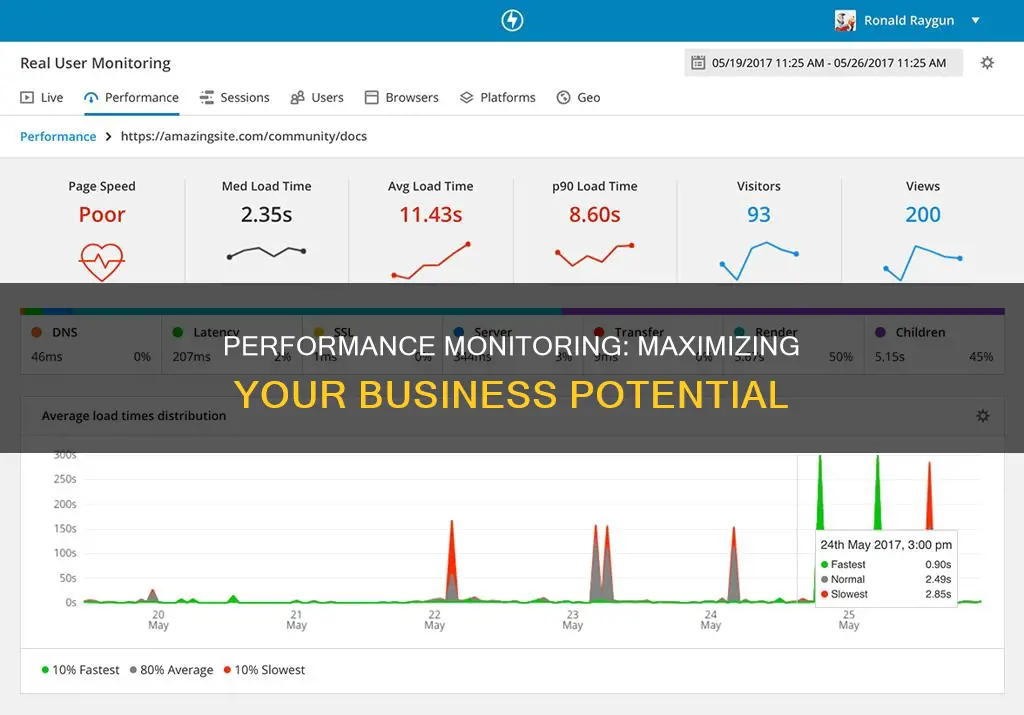
Performance monitoring is a process that involves tracking and evaluating key indicators to assess the overall health and effectiveness of a system, application, or individual. In the context of information technology (IT), performance monitoring is an IT operations practice that focuses on observing metrics related to application and system operations, ensuring their availability, reliability, and performance within agreed-upon service-level objectives. This includes the use of tools like Application Performance Monitoring (APM) to provide insights into potential issues impacting user experience. Beyond IT, performance monitoring is also relevant in business, where it helps optimize operations and maximize profits by tracking metrics such as revenue, customer satisfaction, and operational efficiency. Additionally, performance monitoring plays a crucial role in employee performance evaluation, facilitating continuous learning, development, and strong relationships between management and employees.
What You'll Learn

Performance monitoring tools
There are several performance monitoring tools available, each with unique features and capabilities. Here are some examples:
- Dynatrace: This is a unified observability platform with modules for application observability, security, digital experience, infrastructure observability, automation, and business insights. It offers Grail, a central observability and analytics tool that collects causal data on a large scale and delivers AI-powered insights to inform business decisions. Dynatrace also allows for targeted notifications and supports BizDevOps with built-in BI tools.
- Datadog: An all-in-one monitoring solution that provides a single pane of glass to visualize applications, associated networks, databases, infrastructure, and containers. It includes logging functions, observability pipelines, and scanners for sensitive data. Datadog also enables collaboration between developers and business teams.
- Amazon CloudWatch: Part of the AWS family, CloudWatch is an APM that collects logs and metrics across clouds. It is FedRamp and PCI compliant, offering enhanced security. It integrates natively with other AWS products and services, making it a versatile tool.
- EG Innovations: A unified infrastructure and application monitoring platform for on-premise and cloud-hosted deployments. eG Innovations provides features for monitoring applications built using Node.js, including automatic alerts for resource usage and the ability to evaluate transaction details and URLs.
- SolarWinds Server and Application Monitor: A multi-platform monitoring solution that works with IaaS, SaaS, and PaaS setups. It offers dependency mapping, allowing users to poll dependencies and increase visibility into incoming network connections and their destinations. It also provides forecasts for server resource usage to help pre-empt overloading.
- Google Cloud Operations: Formerly called Stackdriver, this suite of tools provides functions for monitoring, scaling, logging, and troubleshooting. Cloud Logging allows for the extraction of large amounts of data, while Cloud Audit Logs provide near real-time insights into user activity.
- Grafana: An open-source observability platform that can handle full-stack monitoring on cloud and self-hosted environments. It includes Agent, which collects telemetry data and sends it to a compatible endpoint. Grafana is transparent and accessible, allowing users to build their own features and providing a cost-effective option.
- Honeycomb: An event management platform for distributed services, ideal for monitoring games. It includes Service Map, which visually represents all linked services, and BubbleUp, which analyzes requests from different teams to understand how users interact with the product.
- IBM Instana: An APM platform that provides automated full-stack visibility and quick notifications. It offers robust incident reporting features, including AI-powered alerts, and automatically recognizes and logs changes. It also provides contextual information to reduce the time spent addressing issues.
- LogRocket: A monitoring platform focused on session replay for improving web and mobile platform performance. It includes front-end monitoring capabilities and allows for live co-browsing sessions to help users struggling with certain tasks. LogRocket also offers visual tools for analyzing various metrics.
These tools offer a range of capabilities to suit different needs, from full-stack observability to incident management and log analysis. They enable businesses to track and analyze key performance indicators (KPIs), such as revenue, customer satisfaction, and operational efficiency, to evaluate their overall health and effectiveness.
Removing Sidebar on Dual Monitors: A Simple Guide
You may want to see also

Application Performance Monitoring (APM)
APM is particularly important for enterprises to ensure their digital services run smoothly, with minimal downtime, and that customers consistently receive positive experiences. It offers benefits such as improved customer satisfaction, reduced operating costs, and enhanced product development.
APM tracks various metrics, including CPU usage, memory demands, response times, error rates, transaction tracing, server or application instances, user requests, and uptime.
APM solutions can be used for real user monitoring, synthetic monitoring, user-defined transaction profiling, component monitoring, and infrastructure monitoring. Real user monitoring involves collecting and analysing user data to understand an application's performance levels, while synthetic monitoring uses a headless browser to mimic user behaviour for testing.
APM provides a unified full-stack view, giving deep code-level insights and visibility into all application components, such as web services, databases, caching layers, and third-party APIs. It helps to expose the root cause of issues, reduce revenue loss from downtime, improve resource utilisation, and enhance the end-user experience.
APM tools have comprehensive visibility into the application's performance, with real-time monitoring, user-friendly designs, customisable dashboards, and proactive alerting capabilities.
Overall, APM is a crucial practice for businesses to maintain the performance and health of their applications, ensuring a positive user experience and minimising disruptions.
Mortgage Monitoring: Key Factors to Consider Before Buying
You may want to see also

Financial performance monitoring
The process of financial performance monitoring can be broken down into several steps. Firstly, clear financial goals and objectives should be set, aligning with the overall strategic plan of the organisation. These goals should be specific, measurable, achievable, relevant, and time-bound (SMART). Based on these goals, key performance indicators (KPIs) are identified, providing measurable data to track progress. Baselines are then established for each KPI to serve as a reference point, allowing businesses to gauge improvement or identify concerns.
Following this, businesses collect data on their KPIs, ensuring accuracy and consistency. This data is then analysed to evaluate the financial health of the company, comparing actual financial results with budgets and forecasts to identify any variances. This analysis helps businesses make informed decisions, adjust strategies, and improve their financial performance.
Overall, financial performance monitoring is a powerful tool for businesses to gain insights into their financial health, make data-driven decisions, and drive continuous improvement and growth.
Post-Pituitary Gland Removal: Vital Health Checks
You may want to see also

Operational performance monitoring
The first step in operational performance monitoring is to define clear objectives and identify the specific KPIs that align with these goals. For instance, a business may want to monitor and improve operational efficiency, with KPIs such as workflow completion times, resource utilisation rates, and process optimisation metrics.
Next, appropriate tools and systems need to be selected to collect and analyse data. This could include analytics platforms or dedicated performance management software, chosen based on factors like scalability, user-friendliness, and integration capabilities.
Robust processes for data collection are then established, which may involve integrating data sources, setting up tracking mechanisms, and ensuring data accuracy. This step is crucial as it forms the foundation for meaningful insights and effective decision-making.
Before active monitoring begins, baseline metrics for each KPI should be established to provide a reference point for future analysis and to identify areas of improvement. Acceptable thresholds and targets are set, acting as early warning signals to prompt timely interventions and adjustments.
Real-time monitoring is then integrated to track progress and make data-driven decisions. This includes creating regular reports and dashboards visualising key trends, performance against targets, and areas requiring improvement.
By implementing operational performance monitoring, businesses can identify inefficiencies, streamline processes, and optimise resource utilisation. This enables businesses to not only react to challenges but also proactively drive growth and enhance overall performance and resilience.
Why Subwoofers Enhance Rocket Monitors for a Superior Mix
You may want to see also

Employee performance monitoring
Performance monitoring is a process of tracking and analysing key performance indicators (KPIs) to evaluate the overall health and effectiveness of a business. Employee performance monitoring is an important aspect of this, as it helps organisations consistently track and evaluate how employees handle their responsibilities and progress over time.
There are several methods and strategies that can be employed to monitor employee performance effectively:
Regular Check-Ins and One-on-One Meetings
Team leaders and managers should schedule regular meetings with employees to discuss progress, address concerns, and provide guidance and feedback. These meetings help foster a positive working relationship and ensure employees and managers are aligned before year-end reviews.
Performance Management Software
Using dedicated performance management software streamlines the performance monitoring process, making it more efficient and effective. These tools help set goals, track progress, and centralise employee performance data, freeing up time for managers and HR professionals.
Employee Monitoring Software
Employee monitoring software provides hard data to guide conversations about performance and goal setting. It helps identify roadblocks and gives employees and managers the tools to address productivity issues. The choice of software depends on the nature of the work and the organisation's success metrics.
Peer Reviews and 360-Degree Feedback
Involving colleagues, subordinates, and managers in the evaluation process provides a holistic view of an employee's strengths and areas for improvement. Research by Gallup found that teams with managers who received 360-degree feedback showed greater productivity and profitability.
Self-Reported Surveys
Asking employees for their perspective on their performance and that of their colleagues can significantly improve engagement. However, these surveys should be carefully designed to ensure anonymity and provide employees with objective discussion points.
Self-Monitoring Tools
Encouraging employees to use self-monitoring tools like project plans, checklists, activity logs, and time-tracking software helps them monitor their progress and meet goals and deadlines.
Review Work in Progress
Managers should regularly check their employees' work in progress, especially when it comes to end products like databases, reports, phone calls, or any tangible output. This ensures a fair evaluation, as judging employees solely based on the final product may not always be accurate.
Gather Intelligence from Stakeholders
It is important to gather feedback from customers, vendors, coworkers, and other managers about their interactions with specific employees. Asking for descriptions of their work and interactions, rather than evaluations or impressions, provides valuable insights.
Effective employee performance monitoring helps organisations improve productivity, drive business success, and enhance employee engagement and development. It also enables organisations to understand employee engagement levels and address any shortcomings.
Identify Monitor Port Types: A Quick Guide to Checking
You may want to see also
Frequently asked questions
Performance monitoring is the process of tracking and evaluating various aspects of a business or application to ensure optimal performance and efficiency. This includes monitoring financial metrics, operational efficiency, customer satisfaction, and employee performance, as well as application health and user experience.
Performance monitoring provides valuable insights and data that help identify areas of improvement, address problems, and make informed decisions. It helps businesses improve decision-making, boost efficiency, and drive growth by identifying bottlenecks and potential issues.
Performance monitoring utilizes a set of tools and processes to track and analyze key performance indicators (KPIs). It involves defining objectives, identifying relevant KPIs, selecting appropriate monitoring tools, collecting data, establishing baselines, and tracking progress to evaluate the overall health and effectiveness of a business or application.







